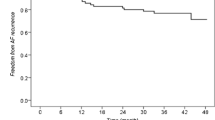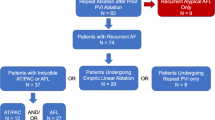Abstract
Purpose
The adjunctive ablation of areas of complex fractionated electrogram (CFE) to pulmonary vein isolation (PVI) is an emerging strategy for patients with non-paroxysmal atrial fibrillation (AF). We studied the long-term outcomes of this approach.
Methods
Sixty-six patients (mean age 58 ± 9, 86.4 % male) with non-paroxysmal AF underwent ablation procedures consisting of PVI plus extensive CFE ablation. Post-ablation atrial tachycardia (AT) was also targeted if presented. All patients were followed up regularly on an ambulatory basis by means of ECG and Holter recordings.
Results
After a mean follow-up period of 40 ± 14 months and 1.7 ± 0.7 procedures, 38 patients (57.6 %) were free of arrhythmias, 15 (22.7 %) displayed clinical improvement and 13 (19.7 %) suffered recurrences of persistent AF/AT. Females displayed poorer long-term outcomes than males (arrhythmia-free 22.2 vs. 63.2 %, p < 0.05). Multivariate analysis demonstrated that long duration of uninterrupted AF prior to the procedure was an additional predictor of long-term failure (odds ratio 1.49, p < 0.01). ROC analysis (area under curve 0.80; p < 0.001) estimated 3.5 years as the optimal cut-off point for predicting long-term failure (sensitivity 85 %, specificity 74 %). The cumulative data showed a significantly higher percentage of arrhythmia-free patients when the duration of AF had been ≤2 years (69.7 %) and ≤4 years (68.9 %) than when it was >4 years (33.3 %; p < 0.01).
Conclusions
PVI + CFE ablation in non-paroxysmal AF appears to provide a reasonable proportion of arrhythmia-free patients during long-term follow-up. Poorer long-term results can be expected among female patients and those with an uninterrupted AF duration of >4 years.



Similar content being viewed by others
References
Elayi, C. S., Verma, A., Di Biase, L., Ching, C. K., Patel, D., Barrett, C., et al. (2008). Ablation for longstanding permanent atrial fibrillation: results from a randomized study comparing three different strategies. Heart Rhythm, 5(12), 1658–1664.
Haissaguerre, M., Hocini, M., Sanders, P., Sacher, F., Rotter, M., Takahashi, Y., et al. (2005). Catheter ablation of long-lasting persistent atrial fibrillation: clinical outcome and mechanisms of subsequent arrhythmias. Journal of Cardiovascular Electrophysiology, 16(11), 1138–1147.
Nademanee, K., McKenzie, J., Kosar, E., Schwab, M., Sunsaneewitayakul, B., Vasavakul, T., et al. (2004). A new approach for catheter ablation of atrial fibrillation: mapping of the electrophysiologic substrate. Journal of the American College of Cardiology, 43(11), 2044–2053.
Oral, H., Chugh, A., Good, E., Wimmer, A., Dey, S., Gadeela, N., et al. (2007). Radiofrequency catheter ablation of chronic atrial fibrillation guided by complex electrograms. Circulation, 115(20), 2606–2612.
Oral, H., Chugh, A., Yoshida, K., Sarrazin, J. F., Kuhne, M., Crawford, T., et al. (2009). A randomized assessment of the incremental role of ablation of complex fractionated atrial electrograms after antral pulmonary vein isolation for long-lasting persistent atrial fibrillation. Journal of the American College of Cardiology, 53(9), 782–789.
Tilz, R. R., Rillig, A., Thum, A. M., Arya, A., Wohlmuth, P., Metzner, A., et al. (2012). Catheter ablation of long-standing persistent atrial fibrillation: 5-year outcomes of the Hamburg Sequential Ablation Strategy. Journal of the American College of Cardiology, 60(19), 1921–1929.
Weerasooriya, R., Khairy, P., Litalien, J., Macle, L., Hocini, M., Sacher, F., et al. (2011). Catheter ablation for atrial fibrillation: are results maintained at 5 years of follow-up? Journal of the American College of Cardiology, 57(2), 160–166.
Hayward, R. M., Upadhyay, G. A., Mela, T., Ellinor, P. T., Barrett, C. D., Heist, E. K., et al. (2011). Pulmonary vein isolation with complex fractionated atrial electrogram ablation for paroxysmal and nonparoxysmal atrial fibrillation: a meta-analysis. Heart Rhythm, 8(7), 994–1000.
Li, W. J., Bai, Y. Y., Zhang, H. Y., Tang, R. B., Miao, C. L., Sang, C. H., et al. (2011). Additional ablation of complex fractionated atrial electrograms after pulmonary vein isolation in patients with atrial fibrillation: a meta-analysis. Circulation: Arrhythmia and Electrophysiology, 4(2), 143–148.
Willems, S., Klemm, H., Rostock, T., Brandstrup, B., Ventura, R., Steven, D., et al. (2006). Substrate modification combined with pulmonary vein isolation improves outcome of catheter ablation in patients with persistent atrial fibrillation: a prospective randomized comparison. European Heart Journal, 27(23), 2871–2878.
Heist, E. K., Chalhoub, F., Barrett, C., Danik, S., Ruskin, J. N., & Mansour, M. (2012). Predictors of atrial fibrillation termination and clinical success of catheter ablation of persistent atrial fibrillation. The American Journal of Cardiology, 110(4), 545–551.
Calkins, H., Kuck, K. H., Cappato, R., Brugada, J., Camm, A. J., Chen, S. A., et al. (2012). 2012 HRS/EHRA/ECAS expert consensus statement on catheter and surgical ablation of atrial fibrillation: recommendations for patient selection, procedural techniques, patient management and follow-up, definitions, endpoints, and research trial design. Europace, 14(4), 528–606.
Verma, A., Sanders, P., Macle, L., Deisenhofer, I., Morillo, C. A., Chen, J., et al. (2012). Substrate and Trigger Ablation for Reduction of Atrial Fibrillation Trial-Part II (STAR AF II): design and rationale. American Heart Journal, 164(1), 1–6. e6.
Aizer, A., Holmes, D. S., Garlitski, A. C., Bernstein, N. E., Smyth-Melsky, J. M., Ferrick, A. M., et al. (2008). Standardization and validation of an automated algorithm to identify fractionation as a guide for atrial fibrillation ablation. Heart Rhythm, 5(8), 1134–1141.
Calo, L., De Ruvo, E., Sciarra, L., Gricia, R., Navone, G., De Luca, L., et al. (2008). Diagnostic accuracy of a new software for complex fractionated electrograms identification in patients with persistent and permanent atrial fibrillation. Journal of Cardiovascular Electrophysiology, 19(10), 1024–1030.
Verma, A., Novak, P., Macle, L., Whaley, B., Beardsall, M., Wulffhart, Z., et al. (2008). A prospective, multicenter evaluation of ablating complex fractionated electrograms (CFEs) during atrial fibrillation (AF) identified by an automated mapping algorithm: acute effects on AF and efficacy as an adjuvant strategy. Heart Rhythm, 5(2), 198–205.
Hunter, R. J., Diab, I., Thomas, G., Duncan, E., Abrams, D., Dhinoja, M., et al. (2009). Validation of a classification system to grade fractionation in atrial fibrillation and correlation with automated detection systems. Europace, 11(12), 1587–1596.
Arbelo, E., Brugada, J., Hindricks, G., Maggioni, A., Tavazzi, L., Vardas, P., et al. (2012). ESC-EURObservational Research Programme: the Atrial Fibrillation Ablation Pilot Study, conducted by the European Heart Rhythm Association. Europace, 14(8), 1094–1103.
Baman, T. S., Jongnarangsin, K., Chugh, A., Suwanagool, A., Guiot, A., Madenci, A., et al. (2011). Prevalence and predictors of complications of radiofrequency catheter ablation for atrial fibrillation. Journal of Cardiovascular Electrophysiology, 22(6), 626–631.
Cappato, R., Calkins, H., Chen, S. A., Davies, W., Iesaka, Y., Kalman, J., et al. (2010). Updated worldwide survey on the methods, efficacy, and safety of catheter ablation for human atrial fibrillation. Circulation: Arrhythmia and Electrophysiology, 3(1), 32–38.
Ammar, S., Hessling, G., Reents, T., Fichtner, S., Wu, J., Zhu, P., et al. (2011). Arrhythmia type after persistent atrial fibrillation ablation predicts success of the repeat procedure. Circulation: Arrhythmia and Electrophysiology, 4(5), 609–614.
Estner, H. L., Hessling, G., Biegler, R., Schreieck, J., Fichtner, S., Wu, J., et al. (2011). Complex fractionated atrial electrogram or linear ablation in patients with persistent atrial fibrillation—a prospective randomized study. Pacing and Clinical Electrophysiology, 34(8), 939–948.
Balk, E. M., Garlitski, A. C., Alsheikh-Ali, A. A., Terasawa, T., Chung, M., & Ip, S. (2010). Predictors of atrial fibrillation recurrence after radiofrequency catheter ablation: a systematic review. Journal of Cardiovascular Electrophysiology, 21(11), 1208–1216.
D’Ascenzo, F., Corleto, A., Biondi-Zoccai, G., Anselmino, M., Ferraris, F., di Biase, L., et al. (2012). Which are the most reliable predictors of recurrence of atrial fibrillation after transcatheter ablation?: a meta-analysis. Int J Cardiol.
De Potter, T., Berruezo, A., Mont, L., Matiello, M., Tamborero, D., Santibanez, C., et al. (2010). Left ventricular systolic dysfunction by itself does not influence outcome of atrial fibrillation ablation. Europace, 12(1), 24–29.
Matsuo, S., Lellouche, N., Wright, M., Bevilacqua, M., Knecht, S., Nault, I., et al. (2009). Clinical predictors of termination and clinical outcome of catheter ablation for persistent atrial fibrillation. Journal of the American College of Cardiology, 54(9), 788–795.
McCready, J. W., Smedley, T., Lambiase, P. D., Ahsan, S. Y., Segal, O. R., Rowland, E., et al. (2011). Predictors of recurrence following radiofrequency ablation for persistent atrial fibrillation. Europace, 13(3), 355–361.
Patel, D., Mohanty, P., Di Biase, L., Sanchez, J. E., Shaheen, M. H., Burkhardt, J. D., et al. (2010). Outcomes and complications of catheter ablation for atrial fibrillation in females. Heart Rhythm, 7(2), 167–172.
Rostock, T., Salukhe, T. V., Steven, D., Drewitz, I., Hoffmann, B. A., Bock, K., et al. (2011). Long-term single- and multiple-procedure outcome and predictors of success after catheter ablation for persistent atrial fibrillation. Heart Rhythm, 8(9), 1391–1397.
Igarashi, M., Tada, H., Sekiguchi, Y., Yamasaki, H., Arimoto, T., Kuroki, K., et al. (2010). Effect of restoration of sinus rhythm by extensive antiarrhythmic drugs in predicting results of catheter ablation of persistent atrial fibrillation. The American Journal of Cardiology, 106(1), 62–68.
Rivard, L., Hocini, M., Rostock, T., Cauchemez, B., Forclaz, A., Jadidi, A. S., et al. (2012). Improved outcome following restoration of sinus rhythm prior to catheter ablation of persistent atrial fibrillation: a comparative multicenter study. Heart Rhythm, 9(7), 1025–1030.
Conflict of interest
There are no conflicts of interest to be disclosed.
Author information
Authors and Affiliations
Corresponding author
Additional information
This study was partly supported by the Trond Mohn Endowment and Helse Vest, Norway
Rights and permissions
About this article
Cite this article
De Bortoli, A., Ohm, OJ., Hoff, P.I. et al. Long-term outcomes of adjunctive complex fractionated electrogram ablation to pulmonary vein isolation as treatment for non-paroxysmal atrial fibrillation. J Interv Card Electrophysiol 38, 19–26 (2013). https://doi.org/10.1007/s10840-013-9816-4
Received:
Accepted:
Published:
Issue Date:
DOI: https://doi.org/10.1007/s10840-013-9816-4




